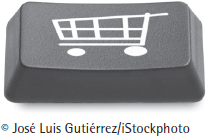INTRODUCTION TO E-COMMERCE AND E-BUSINESS (STUDY OBJECTIVE 1)
THE REAL WORLD

A few years ago, Walmart effected a huge change in the EDI (Electronic Data Interchange) approach to business-to-business transactions. Although EDI had been around for many years, the technology had advanced to allow it to be conducted for free over the Internet. Yet many were concerned about the lack of secure transmission over the Internet. By 2002, Walmart felt the new security standards, called AS2, were adequate. It announced to its 10,000 small and mid-size suppliers that the suppliers had one year to begin using Internet EDI (EDIINT AS2). This was a tremendous change from its traditional EDI and value-added networks, and it had a dramatic impact not only on Walmart's suppliers but on many other large companies and their suppliers worldwide. Some call Walmart the market maker for Internet EDI. Its change to EDIINT led to a revolution of adoption of Internet EDI around the world. Since the buyer and seller have to use the same EDIINT AS2 protocol, Walmart forced a huge number of companies to switch to EDIINT, and in turn, those suppliers used EDIINT with other business customers.
Organizations use information technology to improve efficiency and effectiveness of their operations. Walmart transitioned to Internet EDI to save costs and to take advantage of the new EDI technology. In many cases this IT enablement causes major changes for not only that organization, but also for its trading partners, the entire business world, and other aspects of the economy. The Walmart decision caused 10,000 Walmart suppliers to invest in new IT systems and resulted in major changes in the demand for EDIINT.
The Walmart transition is an example of e-business. E-business is the use of electronic means to enhance business processes. E-business encompasses all forms of on-line electronic trading, consumer-based e-commerce, and business-to-business electronic trading and process integration, as well as the internal use of IT and related technologies for process integration inside organizations.
“E-business” is a term used widely in business and in the mass media. However, there are sometimes misunderstandings about e-business and e-commerce, and any differences between the two. In addition, the sheer number of acronyms in use in e-business and the technological nature of some of the acronyms can make it difficult to understand e-business. The first purpose of this chapter is to define and clarify many of the terms and concepts related to e-business and e-commerce. In addition, this chapter describes the advantages, disadvantages, security issues, and controls related to e-business.
There is some overlap between e-commerce and e-business, and this leads some to confuse the two concepts. E-commerce is electronically enabled transactions between a business and its customers. E-business is a broader concept that includes not only electronic trade with customers, but also servicing customers and vendors, trading information with customers and vendors, and electronic recording and control of internal processes. These internal processes include electronic internal employee services such as access to personnel records, access to fringe benefit information, travel and expense reporting, and purchase of items such as office supplies. Exhibit 14-1 shows the differences and the overlap between the two concepts.
E-commerce is the sale of goods or services from a business to an end-user consumer. Since E-commerce involves selling to consumers, the usual sale will be a relatively small dollar amount when only a few items are sold. The company E-business and E-commerce making the sale will strive for high-volume sales to many consumers to generate a profit. Its customers will use a user-friendly interface, such as a Web browser, to place the order and pay with a credit card. Amazon.com, Inc., is a well-known example of an e-commerce enterprise. The sales between Amazon.com and its customers are sales between a company and end-user customers.

Exhibit 14-1 E-business and E-commerce
On the other hand, e-business is a broader concept that encompasses many business processes, using IT systems to enhance or streamline these processes. A part of e-business includes company-to-company sales. E-business includes the sale of goods, services, or raw materials between companies in a supply chain, as well as internal processes like product design and production. An example of a supply chain sale is a manufacturer that buys raw materials from a vendor, using the Internet as the electronic network. These e-business sales tend to be much larger in dollar value, and there are likely to be many items on each order. The buyer and seller will use common business documents such as purchase orders and invoices, but in electronic form. The software interface between buyer and seller will usually involve more than just a Web browser. The vendor's and buyer's computer systems may be linked, and the vendor may actually be able to access and monitor the buyer's inventory systems.
For a large majority of e-business–enabled companies, the infrastructure that supports e-business and e-commerce includes software systems such as ERP, CRM, and SCM. The details of this infrastructure cannot be covered in this chapter, however will be described in the following chapter.
The most common method of conducting e-commerce and e-business is to use the Internet to electronically exchange data. The next section presents the historical development of the Internet, which provides insight into its current widespread application in the business world.
